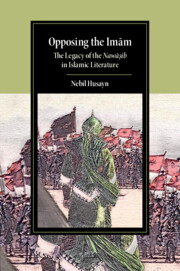Book contents
- Opposing the Imm
- Cambridge Studies in Islamic Civilization
- Opposing the Imām
- Copyright page
- Dedication
- Contents
- Acknowledgments
- Note on Conventions
- Introduction
- 1 ʿAlī: A Contested Legacy
- 2 The Umayyads and the ʿUthmānīs
- 3 The Muʿtazilī: al-Jāḥiẓ
- 4 The Ibāḍī: al-Wārjalānī
- 5 The Sunnī: Ibn Taymiyya
- 6 The Rehabilitation of ʿAlī in Sunnī Ḥadīth and Historiography
- Afterword
- Chapter 1 Appendix: Anti-ʿAlid Statements in Historical Literature
- Chapter 2 Appendix: Reports about the Umayyads and the ʿUthmānīs
- Chapter 5 Appendix: Ibn Taymiyya’s Minhāj al-sunna
- Bibliography
- Index
- Other Titles in the Series
6 - The Rehabilitation of ʿAlī in Sunnī Ḥadīth and Historiography
Published online by Cambridge University Press: 29 April 2021
- Opposing the Imm
- Cambridge Studies in Islamic Civilization
- Opposing the Imām
- Copyright page
- Dedication
- Contents
- Acknowledgments
- Note on Conventions
- Introduction
- 1 ʿAlī: A Contested Legacy
- 2 The Umayyads and the ʿUthmānīs
- 3 The Muʿtazilī: al-Jāḥiẓ
- 4 The Ibāḍī: al-Wārjalānī
- 5 The Sunnī: Ibn Taymiyya
- 6 The Rehabilitation of ʿAlī in Sunnī Ḥadīth and Historiography
- Afterword
- Chapter 1 Appendix: Anti-ʿAlid Statements in Historical Literature
- Chapter 2 Appendix: Reports about the Umayyads and the ʿUthmānīs
- Chapter 5 Appendix: Ibn Taymiyya’s Minhāj al-sunna
- Bibliography
- Index
- Other Titles in the Series
Summary
The concluding chapter reconsiders certain important assumptions about anti-ʿAlid sentiment; namely, that it was limited to the early Umayyads andKhawārij, and that it played no role in shaping Sunnī theology. Instead, this literary excavation reveals strong indications of an enduring legacy that continued to shape medieval and contemporary Sunnī views about ʿAlī. This chapter also discusses the methods that Sunnīs used to transform ʿAlī from a villainous character to a righteous one. It compares canonical ḥadīth with parallel recensions in other works to argue that Sunnī writers actively engaged in the process of rehabilitating ʿAlī by censoring, reinterpreting, and emending texts that portrayed him negatively and by circulating counterclaims that exalted him. Scholars also selectively appropriated anti-ʿAlid reports to modulate ʿAlī’s image. They tempered the pro-ʿAlid (and Shīʿī) portrayal of ʿAlī as an impeccable saint through reports which portrayed him as sinful or frequently mistaken. On the whole, we can consider Sunnī efforts to construct an image of ʿAlī that differed from both Shīʿī and anti-ʿAlid views to have been successful.
- Type
- Chapter
- Information
- Opposing the ImamThe Legacy of the Nawasib in Islamic Literature, pp. 161 - 181Publisher: Cambridge University PressPrint publication year: 2021

